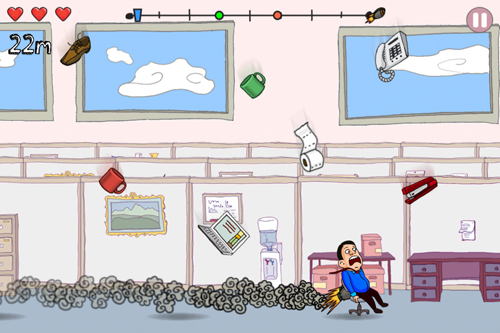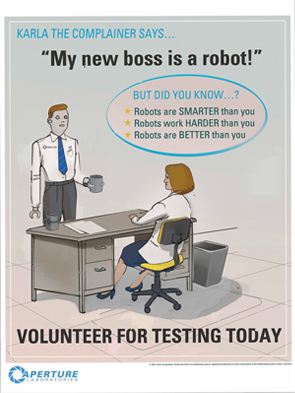I work at a company that develops mobile apps and other digital content. We recently released an iPhone game called "Office Riot," and, as the name suggests, it has a workplace theme. Compared with the number of games that take place on spaceships or in military outposts, there are very few action-oriented games that take place in businesses. Yes, on paper, office work doesn't sound as exciting as shooting zombies, but in practice, the following five games with corporate settings still prove that there's plenty of fun to be had by playing games at work.
1. "Elevator Action" (Taito, 1983)
This innovative arcade game took place entirely inside an office building. It was sort of like the reverse of "Crazy Climber": you started on the roof of the building and worked your way down to the garage by riding elevators and escalators.
The unnamed company featured in the game didn't have a good business model. They seemed to be in the business of storing secret documents. Is there good money in that? You seem to steal a lot of their documents, which must surely impact their profits and drive their insurance through the roof. Plus you shoot most of their security force, which can't be good for employee morale.
2. "Harry the Handsome Executive" (Ambrosia Software, 1997)
The action takes place in the offices of ScumCo. To complete missions and unlock new areas, players scoot around in their office chairs and fire staples at enemies. Just like your real job, there are donuts scattered around to give you power boosts. For entrepreneurs who want to chart their own course, there's a level editor.
3. "Tiny Tower" (NimbleBit, 2011)
In this popular iPhone game, you build and manage a tower for adorable little bitizens. It's an enclosed economic simulation where you control every aspect of the bitizens' lives: they live in your tower; they work in your tower; and they shop in your tower. You even spy on them by reading their BitBook pages -- hey, wait a minute! This little tower you're building is just an updated version of George Pullman's company town! You monster!
Well, at least now we know that Pullman wasn't in it for the money; he just wanted to play the world's first sim game. Learn from Pullman's mistakes and be careful how you manage your Tiny Tower. History has taught us that one day the bitizens are going to go on strike and rise up against you. Speaking of worker revolts...
4. "Office Riot" (Dreamkind, 2011)
This is the iPhone game I shamelessly plugged earlier. In "Office Riot," you play as the world's worst boss, the CEO of X-Ploit Industries. After your latest round of cost-saving measures (a.k.a. paycuts), you finally inspire your fed-up employees to stage a corporate coup d'état. Armed with nothing but your desk chair and a few clever power-ups, you'll have to jump over water coolers and dodge an endless barrage of coffee mugs and keyboards if you want to survive the revolution.
There are two take-away lessons in "Office Riot":
- Don't violate Robert Sutton's "No @$$#*!& Rule" or the concurrently (but independently) developed Wheaton's Law.
5. "Portal 2" (Valve, 2011)
Like the original "Portal," this sequel is set in the facilities of Aperture Science, a research and development company with an on-site manufacturing division. Although both games make excellent use of their industrial settings, "Portal 2" goes further by exploring the corporate offices.
Through a series of pre-recorded audio messages to research test subjects, you get to know Cave Johnson, the CEO of Aperture Science. As you advance through the game, you can see the downfall of the business. The initial optimism and ambition of Cave Johnson's goals gradually deteriorate over time. The story of the company's decline is reinforced by changes in architecture and by a series of posters that become increasingly less motivational. Although Aperture Science began with high hopes for their own future by recruiting "astronauts, war heroes, and Olympians," they are eventually reduced to hiring... well, let's just say the new recruits didn't ride to work in a limo.
Ultimately, Aperture Science's business plan becomes irrelevant, but they stubbornly and dangerously press on with their operations because they've become addicted to the process. The manufacturing continues even though no product ever ships. The product testing continues even though there's no longer a market for any new products. Everything in the facility is so automated that they can't stop working despite the purposelessness of the tasks. It's as if the machines are trying to protect their job security by keeping themselves busy. Even the advanced artificial intelligence that is supposed to be regulating everything can't provide a new vision to an obsolete company. Every day is business as usual.
"Portal 2" isn't just a game; it's a case study. The only thing missing are the balance sheets.


